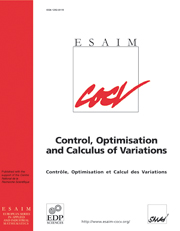Crossref Citations
This article has been cited by the following publications. This list is generated based on data provided by
Crossref.
Amstutz, Samuel
and
Ciligot–Travain, Marc
2010.
Optimality Conditions for Shape and Topology Optimization Subject to a Cone Constraint.
SIAM Journal on Control and Optimization,
Vol. 48,
Issue. 6,
p.
4056.
van der Zee, K. G.
van Brummelen, E. H.
and
de Borst, R.
2010.
Goal-Oriented Error Estimation and Adaptivity for Free-Boundary Problems: The Shape-Linearization Approach.
SIAM Journal on Scientific Computing,
Vol. 32,
Issue. 2,
p.
1093.
Kasumba, Henry
and
Kunisch, Karl
2010.
Shape design optimization for viscous flows in a channel with a bump and an obstacle.
p.
284.
Hintermüller, M.
and
Kovtunenko, V. A.
2011.
From shape variation to topological changes in constrained minimization: a velocity method-based concept.
Optimization Methods and Software,
Vol. 26,
Issue. 4-5,
p.
513.
Ammari, Habib
Garapon, Pierre
Jouve, François
Kang, Hyeonbae
Lim, Mikyoung
and
Yu, Sanghyeon
2013.
A New Optimal Control Approach for the Reconstruction of Extended Inclusions.
SIAM Journal on Control and Optimization,
Vol. 51,
Issue. 2,
p.
1372.
Kasumba, H.
2014.
Shape optimization approaches to free‐surface problems.
International Journal for Numerical Methods in Fluids,
Vol. 74,
Issue. 11,
p.
818.
Kasumba, H.
and
Kunisch, K.
2014.
On Computation of the Shape Hessian of the Cost Functional Without Shape Sensitivity of the State Variable.
Journal of Optimization Theory and Applications,
Vol. 162,
Issue. 3,
p.
779.
Kiniger, Bernhard
2015.
A Transformation Approach in Shape Optimization: Existence and Regularity Results.
Numerical Functional Analysis and Optimization,
Vol. 36,
Issue. 12,
p.
1585.
Sturm, Kevin
2015.
Minimax Lagrangian Approach to the Differentiability of Nonlinear PDE Constrained Shape Functions Without Saddle Point Assumption.
SIAM Journal on Control and Optimization,
Vol. 53,
Issue. 4,
p.
2017.
Kaltenbacher, Barbara
2015.
Mathematics of nonlinear acoustics.
Evolution Equations & Control Theory,
Vol. 4,
Issue. 4,
p.
447.
Sturm, Kevin
2015.
New Trends in Shape Optimization.
Vol. 166,
Issue. ,
p.
271.
Gangl, P.
Langer, U.
Laurain, A.
Meftahi, H.
and
Sturm, K.
2015.
Shape Optimization of an Electric Motor Subject to Nonlinear Magnetostatics.
SIAM Journal on Scientific Computing,
Vol. 37,
Issue. 6,
p.
B1002.
Kaland, L.
Sonntag, M.
and
Gauger, N. R.
2015.
Advances in Evolutionary and Deterministic Methods for Design, Optimization and Control in Engineering and Sciences.
Vol. 36,
Issue. ,
p.
143.
Laurain, Antoine
and
Meftahi, Houcine
2016.
Shape and parameter reconstruction for the Robin transmission inverse problem.
Journal of Inverse and Ill-posed Problems,
Vol. 24,
Issue. 6,
p.
643.
Kaltenbacher, Barbara
and
Peichl, Gunther
2016.
The shape derivative for an optimization problem in lithotripsy.
Evolution Equations and Control Theory,
Vol. 5,
Issue. 3,
p.
399.
Sonntag, Matthias
Schmidt, Stephan
and
Gauger, Nicolas R.
2016.
Shape derivatives for the compressible Navier–Stokes equations in variational form.
Journal of Computational and Applied Mathematics,
Vol. 296,
Issue. ,
p.
334.
Welker, Kathrin
2017.
Geometric Science of Information.
Vol. 10589,
Issue. ,
p.
65.
Fischer, Michael
Lindemann, Florian
Ulbrich, Michael
and
Ulbrich, Stefan
2017.
Fréchet Differentiability of Unsteady Incompressible Navier--Stokes Flow with Respect to Domain Variations of Low Regularity by Using a General Analytical Framework.
SIAM Journal on Control and Optimization,
Vol. 55,
Issue. 5,
p.
3226.
Bociu, Lorena
and
Zolésio, Jean-Paul
2017.
Hyperbolic Equations with Mixed Boundary Conditions: Shape Differentiability Analysis.
Applied Mathematics & Optimization,
Vol. 76,
Issue. 2,
p.
375.
Kasumba, Henry
Kakuba, Godwin
and
Magero, John Mango
2017.
Progress in Industrial Mathematics at ECMI 2016.
Vol. 26,
Issue. ,
p.
657.




